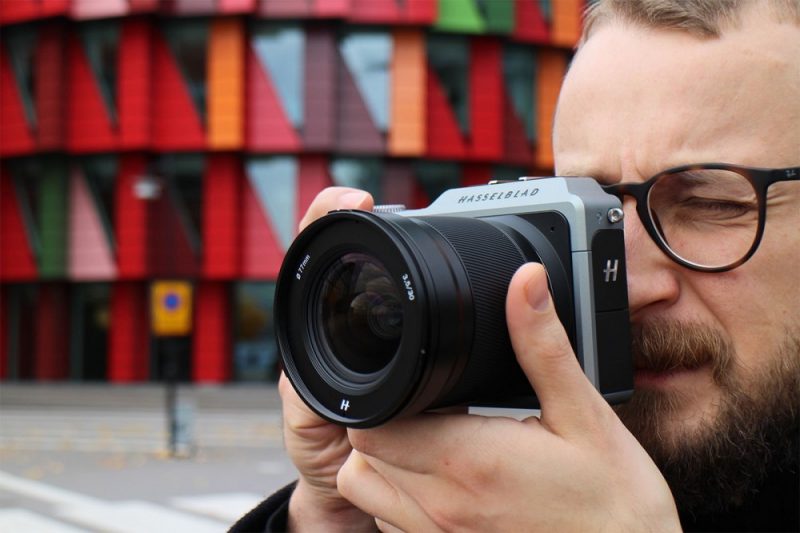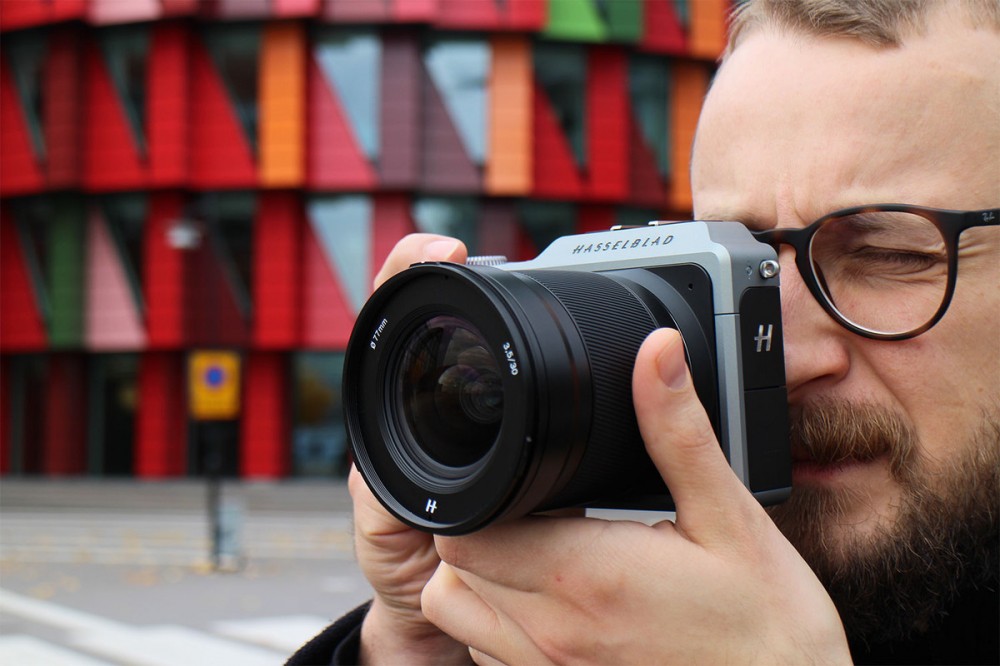TO FIND ITS FUTURE, HASSELBLAD HAD TO LOOK BACK TO ITS PAST


A man I didn’t know strode purposefully toward the table while I was having lunch, stopped, and asked, “Is that the new Hasselblad camera?” He had a good eye, because one of my companions was indeed holding the new Hasselblad X1D camera. I was taken aback. It’s so new, and in such short supply, the only one available for me to try on the day was one used by the R&D team. I stared blankly, and wondered if the whole thing was an elaborate PR setup.
It wasn’t. I was in Gothenburg, Sweden, and the city is to Hasselblad what Modena, Italy is to Ferrari, and Cupertino, California is to Apple. The camera maker is as celebrated there as those other iconic brands are in their hometowns. Once his question was answered, the inquisitive camera fan smiled, talked about how he aspired to buy one in the near future, and closed by saying, “I’m happy to see Hasselblad make a comeback.”
Hasselblad has spent two years turning itself around after a troubling period, and the X1D (and the H6D before it) is the exciting result of its hard work. Although the camera is a departure from the professional equipment many may expect it to produce, it’s true to the vision of high quality photography that founder Victor Hasselblad originally had back in 1941, when he launched the company and went on to devise the first, and now legendary, V Series cameras.
“I am the camera”
To understand the importance of the X1D, and see how entrenched Hasselblad is in Gothenburg itself, we took a trip to the Hasselblad Center in the city. Among other things, it’s home to the Hasselblad Foundation, set up in 1979 after Victor Hasselblad’s death, where photographic research is carried out, academics can study the art, and exhibitions based on the Hasselblad archives are held for the public to enjoy.
Before you enter, just off to the right and set between two trees, is a statue of Victor Hasselblad, clutching one of his own cameras. The statue was erected to commemorate what would have been his 100th birthday, and a plaque nearby reiterates an oft-told story of the man himself. Legend has it that when visiting America he was asked by U.S. customs upon entry if he had anything to do with Hasselblad cameras. Hasselblad replied simply, “I am the camera.”
There was a good reason for his, and Hasselblad’s fame. Name an iconic picture taken in the last 75 years and there’s a strong chance it came from one of the company’s cameras. The Beatles crossing Abbey Road. Check. Bert Stern’s Marilynn Monroe portraits, Ansel Adams shot of the Yosemite Half Dome with the moon in the sky, and Albert Watson’s black and white portrait of Steve Jobs. Check, check, and check again.
One small step
And the moon landings. Let’s not forget about them. So important are they to Hasselblad’s success, a moon boot print is sculpted into the base of the statue, alongside Hasselblad’s own feet. The latest exhibition at the Center, called “Hasselblad on the Moon,” illustrates how interconnected NASA and Hasselblad became. From one of the actual Hasselblad camera backs used on the moon, to a bracelet of charms owned by Victor’s wife Erna, where each charm was carried in secret by an astronaut to the moon and back, and even candid photos of Buzz Aldrin and his family exploring the Swedish woods with the nature-loving Victor and Erna; the shared passion for science, advancement, and exploration is obvious.
The latest exhibition at the Center, called “Hasselblad on the Moon,” illustrates how interconnected NASA and Hasselblad became.
Our tour was given by Elsa Modin, who has worked for the Foundation since 1999 and as librarian at the extensive photographic library at the Center, is responsible for the historical archive of more than 14,000 books. She is as passionate and knowledgeable about the company as any member of the tifosi is about Ferrari. Despite never having met Victor Hasselblad, she knew the history, the stories, the photographs, and the influence of Hasselblad inside out.
“It almost feels as if I did met him and his wife Erna, after hand.ing all the letters, all the photos, the documents, and the cameras for so many years,” she told Digital Trends.
If there was a Hasselblad flag, it would be easy to imagine it flying outside her home.
In fact, there is a Hasselblad flag. Returning to Hasselblad’s offices after the exhibition, we stopped outside a beautiful building that had been built by the Hasselblad family, which was once the site of Hasselblad’s first factory, and where Victor Hasselblad once lived. Now a very upmarket residential building overlooking the river, it’s known as Hasselblad House, and a flag flies outside proclaiming it.

It’s one of many places Hasselblad devotees can visit in the city, but not all celebrate the best of times. The starkest reminder of its darkest days is to visit the ultra-modern custom headquarters in the city center that is now home to a Swedish TV broadcaster amongst others, after the camera company was forced to vacate during the mid-2000s, when sales slumped as the industry changed immeasurably.
Core DNA
This occurred in the middle of an identity crisis for Hasselblad, as it struggled to fight for attention during the digital and smartphone photography boom. Former Vertu CEO Perry Oosting joined Hasselblad as CEO in 2015, and work accelerated on developing the professional H6D and the X1D, which would eventually join the H Series cameras as the prime models in its lineup. The change had begun, and it was looking back at Victor Hasselblad’s original vision that dictated the direction.
“We want to build the brand back from the core DNA,” Oosting told Digital Trends. “Form and functionality come together, along with image quality and Swedish craftsmanship. The X1D is built on that core DNA. When Victor Hasselblad was frustrated with his first camera, he made the 1600, which was so much smaller than conventional cameras at the time. That’s what we’re trying to do with the X1D. It can work as a studio camera, but with that portability. When Victor made the V System, he never wanted them to be professional only. It was a camera for a wider audience. The X1D concept is not new, but it is the first compact digital medium format camera that can bring the medium format to enthusiasts at an affordable price.”
Smartphone photography
Hasselblad is celebrating its 75th anniversary, and part of this is to make new partnerships that help promote the company name, especially to those that may not be aware of it. One such partnership is with Motorola, which resulted in the Hasselblad True Zoom Moto Mod for the Moto Z smartphone.
“It was interesting to work with Motorola, it gave us freedom; and because it’s made by Motorola, it’s ‘cool.’”
The company has teamed up with Sony and Vertu, but concentrated on co-branding, in the past. Oosting explained why it has been different with Motorola.
“We could be involved in design, the optics, and adding RAW support. It was interesting to work with Motorola, it gave us freedom; and because it’s made by Motorola, it’s ‘cool.’”
This coolness is important. It helps bring the Hasselblad name right up to date, associating it with modern hardware, and potentially introducing it to a generation being entranced by photography using their smartphone. Hasselblad wants to forge more mobile relationships in the future, but has no intention of making a smartphone of its own.
“We have no agreements with anyone, but a lot of requests,” Oosting smiled, acknowledging that imaging is a key attribute of a smartphone today. The company’s not rushing into anything, and only wants to be involved if it’s part of of a project where “we can make a difference, and bring something new to the market,” he said.
All the right moves
If the mystery man in the restaurant, who spotted a rarely seen camera from across the room and correctly identified it, is representative of the population, Hasselblad has Sweden’s support. Nobody is shouting and cheering in the streets, like the tifosi may do for Ferrari – the Swedes aren’t really like that – but the X1D is Hasselblad’s equivalent to a race win at Monza.
It’s a rare thing to find a company that inspires such passion from people, but by delving into Hasselblad’s fascinating history in a city where it’s seemingly around every corner, it’s easy to see how it does. By returning to Victor Hasselblad’s vision, and properly addressing the masses of mobile photography fans in the world, the newly invigorated Hasselblad is making the right moves to ensure that passion continues.










